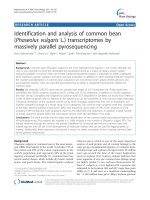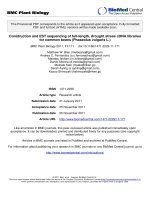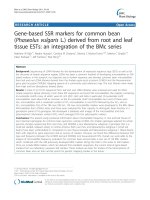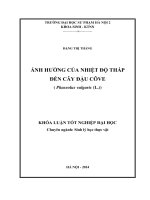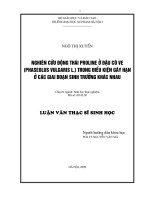Response of French bean (Phaseolus vulgaris L. cv. Arka Arjun) to rhizobium inoculation under varied levels of nitrogen and molybdenum
Bạn đang xem bản rút gọn của tài liệu. Xem và tải ngay bản đầy đủ của tài liệu tại đây (332.94 KB, 9 trang )
Int.J.Curr.Microbiol.App.Sci (2020) 9(3): 2759-2767
International Journal of Current Microbiology and Applied Sciences
ISSN: 2319-7706 Volume 9 Number 3 (2020)
Journal homepage:
Original Research Article
/>
Response of French Bean (Phaseolus vulgaris L. cv. Arka Arjun) to
Rhizobium Inoculation under Varied Levels of Nitrogen and Molybdenum
Subhankar Biswas, Anannya Banerjee, Pinaki Acharyya* and Nirmalya Chakraborty
Department of Horticulture, Institute of Agricultural Science
University of Calcutta, Kolkata-700019, WestBengal, India
*Corresponding author
ABSTRACT
Keywords
French bean,
Rhizobium,
Nitrogen,
Molybdenum,
Yield attribute
s.
Article Info
Accepted:
22 February 2020
Available Online:
10 March 2020
A study was conducted on French bean (Phaseolus vulgaris) at the coastal saline zone of
West Bengal during winter 2017-18 and 2018-19. The soil texture was clay loam with pH
7.03. A location specific trial was done to standardize the combination dose for French
bean towards productivity enhancement. The experiment was laid out in randomized bock
design having 3 replications with 12 different treatments. The investigation was conducted
with two strains of Rhizobium species -R (Rhizobium V1B/Bean-15 & Rhizobium
V1B/F.bean-21) interacting on three applied levels of nitrogen-N (75%, 50%, 25% of the
recommended dose @ 40kg/ha), and two levels of ammonium molybdate-Mo (50%, 100%
of the recommended dose @30kg/ha) in variety “Arka Arjun” of French bean. The study
generated information on the combined effects of biofertilizer and chemical fertilizer on
several morphological attributes, protein content, nodulation and their final culmination on
the yield. Studies on changing soil profile with respect to available nitrogen and population
count of nitrogen fixers were also worked out to support the results. The mean sum of
squares for all the traits were found statistically significant. The conclusive study suggests
that the following treatment combinations viz. Rhizobium V 1B/bean-15 +Nitrogen 50 %
+Molybdenum 100 % and Rhizobium V1B/bean-15 +Nitrogen 25 % + Molybdenum 50 %
applied to the French bean cv. Arka Arjun may be advised to the farmers of Coastal Saline
Zone of West Bengal for productivity enhancement and maintaining soil sustainability.
Introduction
French bean (Phaseolus vulgaris L.) is a pulse
crop which is rich in vitamins and minerals
like calcium, iron, magnesium, phosphorus,
potassium, zinc etc. It is a short duration high
yielding grain legume crop that can be used
both as pulse and vegetable French bean is
consumed as immature tender pods, green
grains are consumed as vegetables and dry
grains are a good source of protein. French
bean also depicts some medicinal properties
that include control of diabetes, cardiac
problems and natural cure for bladder burn.
As per the FAO estimates, it is grown in the
world in an area of 28 million hectares with
an annual production of 20 million tons and
productivity of 729 kg/ha (Prakash and Ram,
2014). Foliage of the crop may also provide
2759
Int.J.Curr.Microbiol.App.Sci (2020) 9(3): 2759-2767
hay, silage and green manures and plants can
be fed to cattle after harvest (Kakon et al.,
2016).
Agronomical practices play a pivotal role to
exploit the genetic worth of a crop for
obtaining good production. Different growth
and yield attributing traits are highly affected
by the nutrient status of the growing media.
French bean unlike other pulses has
determinate type nodules and thus nitrogen
fertilizers are to be applied in lower quantity
than other pulses. Nitrogen deficiency in most
crops constraints leaf area expansion,
enhances
leaf
senescence,
inhibits
photosynthetic rate and consequently reduces
the crop productivity (Machler et al., 1988
and Wolfe et al., 1988).
Bean legumes are capable of fixing
atmospheric nitrogen by the presence of
Rhizobium bacteria at their root nodules.
Molybdenum is an essential element that acts
as an essential cofactor in stimulating Nfixing activity of Phaseolus vulgaris
(Vakhaniya et al., 1990, Reyes et. al., 2016).
It is also essential for certain nitrogen
transformations in microorganisms as well as
in plants. Molybdenum increases nitrogenous
activity and extends the period of high nitrate
reductase activity, with a consequent increase
in total shoot nitrogen.
The main effect of Mo fertilizer application is
to increase the size of nodules and avoidance
of nodule senescence, therefore maintaining a
longer period of effective nitrogen fixation
(Vieira et al., 1998). Molybdenum is
important and has special significance due to
its contribution in activation of several
enzyme systems and physiological activities
within the plant body. Molybdenum is a
constituent part of the enzyme nitrate
reductase concerned with the reduction of
nitrate to nitrite in both microorganisms and
higher plants (Lal et al., 2018).
Declining soil fertility and high cost of
fertilizer are major limitations to crop
production. Requirements for nitrogen exceed
any other major nutrients needed for
agriculture and rarely does soil have enough
of this nutrient to produce high sustainable
yields
(Mkandawire
et
al.,
1998,
Woldeyohannes et al., 2007).
Reduced dependence on nitrogenous fertilizer
and adaptation to farming practices that
favour more economically viable and
environmentally prudent nitrogen fixation
will benefit both agriculture and the
environment (Woldeyohannes et al., 2007,
Zaman-Allah et al., 2007). Biological
Nitrogen Fixation (BNF) has been used in
farming systems to reduce the fertilizer
expenses and inoculation with an effective
and persistent rhizobium strain has several
advantages
that include non-repeated
application of nitrogen fertilizers and higher
pod yield due to increase in nodulation
(Otieno et al., 2009).
The present investigation was conducted to
assess the interaction of two strains of
Rhizobium species on three different applied
levels of nitrogen and two levels of
ammonium molybdate in variety Arka Arjun
of French bean to generate information of its
combined effects on several morphological
attributes, protein content, nodulation and its
final impact on the yield. Assessment on
changing soil profile with respect to available
nitrogen and population count of nitrogen
fixers were also worked out.
Materials and Methods
The present field experiment was carried out
at the Agricultural experimental farm of
Calcutta
University
at
Baruipur,24–
Parganas(South) [88°28′ East longitude,
22°22′ North latitude] during winter season of
2017-2018 and 2018- 2019. Topography of
the land was uniform with medium fertility
2760
Int.J.Curr.Microbiol.App.Sci (2020) 9(3): 2759-2767
and clay loam texture. The physicochemical
characteristics of the soil were determined by
following the standard methods and are being
presented in Table 1.
The experiment was laid out in a randomized
bock design having three replications with 12
different treatments. The size of the plot was
4 x 1 m2 and bund width between plots was
0.26 m with 1m of irrigation channels. Net
area of the experiment was 210 m2 with a
spacing of R to R 20cm, P to P 20 cm. The
French bean variety seeds (Phaseolus vulgaris
L. cv Arka Arjun) were collected from Indian
Institute
of
Horticultural
Research,
Bengaluru. The bean cultivars were raised
under three levels (75 %, 50 % and 25 %) of
recommended nitrogen dose in the form of
Urea.
Phosphorous and Potassium were applied in
the form of Single Super Phosphate and
Murate of Potash following the recommended
dose of fertilizer N:P:K (40:60:50).
Micronutrient Molybdenum was applied at
two levels viz. Mo1and Mo2 @ 50% and
100% of recommended „Mo‟ dose. Two
microbial inoculants namely R1-Rhizobium
V1B/Bean-15 and R2- Rhizobium V1B/F
Bean-21 strains used for the seed treatments
during the study were collected from
Vivekananda Institute of Bio technology,
Nimpith, West Bengal. The moist seeds were
thoroughly mixed with the inoculant under
the shade and were placed in the furrows at
the recommended spacing of plots.The plants
were thinned to one plant per hill after
emergence.
The plants were thinned to one plant per hill
after emergence. The treatment details of the
study are: T1 (R1,N1,Mo1), T2 (R1,N2,Mo1), T3
(R1,N3,Mo1), T4 (R1,N1,Mo2), T5 (R1,N2,Mo2),
T6 (R1,N3,Mo2), T7 (R2,N1,Mo1), T8
(R2,N2,Mo1),T9 (R2,N3,Mo1), T10 (R2,N1,Mo2),
T11 (R2,N2,Mo2), T12 (R2,N3,Mo2) and T13
(Control).
(R1-RhizobiumV1B/bean-15,R2RhizobiumV1B/F.bean-21, N1-Nitrogen 75 %,
N2- Nitrogen 50 %, N3-Nitrogen 25 %, Mo1Molybdenum 50 %, Mo2- Molybdenum 100
%.
Five random plants were selected from the
plots and 50% flowering, height of the plants,
leaf count and number of branches were
recorded from the selected plants on the 70th
day after sowing. Leaf area was determined
from fresh and matured leaves collected from
the mid portion of the plant and the data was
recorded by utilizing a Leaf area meter
(Makeup: Systronics, Model No: 211). Fresh
and dry weight of shoots and roots were taken
independently on a single pan electrical
balance. Yield attributes like average pod
weight, number of fruits per plant and number
of seeds per pod were recorded from the
selected plants.
Dry weight of pod was calculated on the basis
of 100 g of fresh weight per treatment plot.
Yield per hectare was calculated by
converting average yield obtained from each
plot representing the treatments under three
replicates and up scaled to the predictable
yield. Number of nodules of five random
tagged plants were counted and fresh weight
of the nodules was recorded by using a
precision electronic balance (Makeup: Kern,
Model: 440-21N).Oven dry weight of the
fresh nodules after attaining a constant weight
at 50-520C were also recorded using a
precision electric balance. Estimation of the
amount of protein in the pods was carried out
by following Lowry‟s method (Lowry et al.,
1951).
Total number of nitrogen fixers was counted
by recording the colony forming unit (CFU)
on Jensen‟s agar plates grown from serially
diluted soil samples after incubation for 72hrs
at 28°C (Aneja,2003). Available nitrogen in
the soil at pre and post experimentation was
2761
Int.J.Curr.Microbiol.App.Sci (2020) 9(3): 2759-2767
estimated by following the method of Jackson
(2005).
and development of plants (Kandil et al.,
2013).
Plot means of one pooled data over two
seasons were used for statistical analysis. A
three way factorial design was followed for
interpretation of the results, Factor A
representing two Rhizobium levels, Factor B
representing three N levels applied in the
form of Urea while Factor C represented the
two molybdenum levels in the form of
Ammonium molybdate.
There was a significant increase in number of
branches along with shoot fresh and dry
weight. Increase in root fresh and dry weight
was also recorded that was a consequent
result of increase in plant height due to
application of Mo and P fertilizers (Maingi et
al., 1999 and Kandil et al., 2013).
The entire analysis was carried out at the
Department of Horticulture, Institute of
Agricultural Science, University of Calcutta
using statistical package “Three factor
Factorial CRD” software available online.
Activity of rhizobium resulted in significant
increase in number of pods per plant with
highest pod length and diameter on
application of 100 % molybdenum in
combination with R1 V1B/bean15 (Table 3).
Results and Discussion
This was mainly due to the availability of the
microorganism to fix atmospheric nitrogen to
soil which was made available to the growing
plants beside secretion of growth promoting
substances which were partly responsible for
the enhanced plant growth and yield. Reyes et
al., (2016) revealed that inorganic N
fertilization and rhizobium inoculation with
additional molybdenum probably increased
nitrate reductase activity which in turn
increased pod yield.
Growth characters
Beneficial effect of the combined application
of rhizobium culture with nitrogen fertilizer
and molybdenum on growth and development
of French bean has been clearly brought out
in this investigation.
Application of 25% nitrogen and 50%
molybdenum
along
with
rhizobium
V1b/Bean15 showed a notable increase in
growth parameters like plant height, leaf area,
number of leaves, shoot and root fresh and
dry weight than control (Table 2). It seemed
that molybdenum played a major role either in
combination with nitrogen or the strains of
rhizobium to increase plant height (Masanta
and Biswas,2009).
Leaf area and number of leaves as influenced
by rhizobium inoculants and different levels
of nitrogen and molybdenum showed
significant increase for the trait. The
synergistic effect between Mo and P
fertilizers may have influenced better growth
Yield and yield attributes
Pod fresh and dry weight also increased
during the study which suggests that
application of inorganic N may be sometimes
better over biological N2 fixation alone
(Beshir et al., 2015). More over French bean
has greater mineral N uptake efficiency as
compared to N2 fixation (George and
Singleton, 1992).
This may indicate that French beans early end
demand could have been satisfied from the
applied N source than N from fixation that
have contributed to the increase in pod fresh
weight at a later stage.
2762
Int.J.Curr.Microbiol.App.Sci (2020) 9(3): 2759-2767
Table.1 Soil parameter analysis
Mechanical
Analysis
Sand - 25%
Silt - 35%
Clay - 40%
Physical Analysis
Chemical Analysis
a) Apparent density -1.24gm/cc
b) Absolute specific gravity -2.56
c) Maximum water holding
capacity - 53.80%
a) Soil pH –7.03
b) EC- 329 milliohms‟
c) TDS-241ppm.
d) Salt-156ppm.
e) Available nitrogen- 54.786
kg/ha
f)Available phosphorus30kg/ha
g) Available potassium260kg/ha.
Table.2 Effect of Rhizobium, nitrogen and molybdenum treatments on morphological traits
of Phaseolus vulgaris L. (Pooled data of 2 years)
Treatment
Leaf
Area
(cm2)
64.50
Number of
Leaves/Plant
Number of
Branches/Plant
T1
Plant
height
(cm)
36.91
Shoot Dry
Weight(g)
Root Fresh
Weight(g)
5.83
Shoot
Fresh
Weight(g)
34.13
14.48
14.48
Root Dry
Weight
(g)
5.75
42.00
T2
38.63
60.11
36.66
6.16
39.53
14.14
14.14
6.79
T3
41.22
81.96
42.00
5.96
41.83
13.43
13.43
7.08
T4
37.83
64.56
35.66
6.25
40.46
15.97
15.97
6.69
T5
40.48
74.95
35.66
6.86
35.58
15.50
15.50
6.74
T6
40.73
74.96
36.00
7.36
35.39
13.06
13.06
6.86
T7
36.56
82.93
35.33
6.02
40.37
14.28
14.28
5.75
T8
39.85
64.83
32.33
5.76
34.97
11.78
11.78
6.49
T9
38.80
73.23
35.00
5.88
32.95
13.93
13.93
6.17
T10
38.58
63.82
31.33
5.58
55.22
13.68
13.68
6.08
T11
39.40
64.18
32.33
6.39
35.19
13.28
13.28
6.29
T12
41.00
61.21
37.00
7.04
60.15
19.20
19.20
8.70
Control
24.44
60.50
27.33
4.73
25.93
10.66
10.66
4.34
CV (%)
4.82
7.94
6.27
9.67
4.92
3.27
3.27
6.42
CD .5(%)
3.19
9.32
3.81
1.02
3.37
0.79
0.79
0.72
T1 (R1,N1,Mo1), T2 (R1,N2,MO1), T3 ( R1,N3,MO1) , T4 (R1,N1,MO2), T5 (R1,N2,MO2), T6 (R1,N3,MO2), T7 (R2,N1,MO1),T8
(R2,N2,MO1), T9 (R2,N3,MO1), T10 (R2,N1,M02), T11(R2,N2,MO2), T12 (R2,N3,MO2)
(R1- Rhizobium V1B/bean-15, R2- Rhizobium V1B/F.bean-21, N1-Nitrogen 75 %( 315g/plot), N2- Nitrogen 50 %( 210g/plot), N3Nitrogen 25 %( 105g/plot),M1-Molybdenum50 %( 60mg/plot), M2- Molybdenum 100 %( 120mg/plot).
2763
Int.J.Curr.Microbiol.App.Sci (2020) 9(3): 2759-2767
Table.3 Effect of Rhizobium, nitrogen and molybdenum treatments on yield and yield related
traits of Phaseolus vulgaris L. (Pooled data of 2 years)
Treatment
Number
of
Pods/Plant
Pod
length(cm)
Pod
diameter(mm)
Pod fresh
Weight(g)
Pod
dry
weight
(g)
Number
of
seeds/pod
Number of
nodule/Plant
Nodule
fresh
weight(mg)
Nodule dry
weight(mg)
Yield/ha
T1
24.65
14.28
8.27
44.11
7.37
6.00
29.50
1073.00
332.00
4488.74
T2
21.96
13.67
7.97
34.15
4.81
4.96
20.50
890.66
201.00
3051.96
T3
22.66
14.48
8.33
39.67
5.99
5.46
23.50
936.33
215.00
3724.45
T4
21.00
14.17
7.99
37.55
5.03
5.26
20.50
733.00
153.66
3121.40
T5
25.41
14.85
8.77
44.11
6.46
5.96
35.50
1350.00
496.33
4578.69
T6
25.21
14.66
8.56
39.99
5.90
5.83
29.50
1104.00
410.00
4170.51
T7
21.75
14.25
8.13
32.39
5.07
5.50
20.50
897.00
186.33
2948.65
T8
22.13
13.86
7.91
28.92
6.03
5.50
19.50
892.33
191.00
2675.14
T9
22.38
14.48
7.97
35.16
4.87
5.13
20.50
693.00
150.33
3208.06
T10
22.51
14.26
8.21
35.87
5.13
5.71
24.00
965.33
213.33
3392.31
T11
23.86
14.52
8.38
41.17
6.51
6.51
32.00
1070.33
338.66
4188.93
T12
23.77
14.38
8.68
38.91
7.21
6.70
26.50
1057.33
332.00
3725.38
Control
17.80
13.48
7.58
34.01
5.03
4.70
18.50
613.33
129.33
2621.2
CV (%)
3.12
2.94
4.00
3.28
7.39
2.18
7.60
6.95
6.993
4.18
CD
1.22
0.71
0.56
2.09
0.73
0.21
4.21
114.41
31.67
255.72
0.5(%)
T1 (R1,N1,Mo1), T2 (R1,N2,MO1), T3 ( R1,N3,MO1) , T4 (R1,N1,MO2), T5 (R1,N2,MO2), T6 (R1,N3,MO2), T7 (R2,N1,MO1),T8 (R2,N2,MO1), T9
(R2,N3,MO1), T10 (R2,N1,MO2), T11(R2,N2,MO2), T12 (R2,N3,MO2)
(R1- Rhizobium V1B/bean-15, R2- Rhizobium V1B/F.bean-21, N1-Nitrogen 75 %( 315g/plot), N2- Nitrogen 50 %( 210g/plot),
N3-Nitrogen 25 %( 105g/plot),M1-Molybdenum50 %( 60mg/plot), M2- Molybdenum 100 %( 120mg/plot).
Fig.1 Protein content of fresh pods of Phaseolus vulgaris L. (Pooled data of 2 years)
2764
Int.J.Curr.Microbiol.App.Sci (2020) 9(3): 2759-2767
Fig.2 Available nitrogen content of soil treated with different combinations of Rhizobium,
nitrogen and molybdenum (Pooled data of 2 years)
Fig.3 Total nitrogen fixers present in the soil under different treatment combinations
(Pooled data of 2 years)
Increase in number of seeds per pod
suggested that the inoculated bean treatments
with rhizobium V1B/F.bean-21 strain and Mo
addition showed the best effect in increasing
number of seeds highlighting the important
role of molybdenum on nitrogenase and
xanthine oxydase-de hydrogenase activity in
the atmospheric N reduction and purine
metabolism respectively (Marschner, 1995).
Number of nodules and maximum nodule
fresh and dry weight showed a significant
increase during the study. Inorganic
fertilization with additional Mo treatment and
rhizobial inoculation showed the best effect in
increasing nodulation in beans. Optimal
supply of Mo to the beans inoculated with
Rhizobium etli, increased nodule number by
88% which could be explained by the
importance of Mo in symbiotic N fixation of
legume, which is an important co-factor of
nitrogenase complex and xanthine oxydase,
for N fixation and purine metabolism
respectively (Reyes et al., 2016). It was
revealed from the data that application of
rhizobium
treatments
with
100%
molybdenum resulted in the best yield for
treatment T5 over the control which suggests
that
correct
bacterization
(symbiotic
2765
Int.J.Curr.Microbiol.App.Sci (2020) 9(3): 2759-2767
association) along with judicious application
of chemical fertilizers and essential cofactors
increases growth and yield that might result in
increase in net economic return (Table 2). The
treatments showed statistically significant
protein content for fresh pods of French
beans. Highest protein content was noted to
be 9.007mg/ml (Fig.1).
Application of molybdenum resulted in yield
enhancement through total N accumulation in
seeds as well as seed protein content of
French bean (Vieira et al., 1998; Somani,
2005; Kandil et al., 2013). Increase in
available nitrogen was recorded post
experimentation for soil which gives an
insight of the amount of N being added to the
soil per unit (Fig 2).Notable increase in
colony forming unit (CFU) was observed that
revealed the increase in population of total
nitrogen fixers count due to different
treatments (Fig 3).
The overall performance of French bean in
Coastal Saline Zone of West Bengal was
satisfactory. All the combinations of
rhizobium, nitrogen and molybdenum had
good influence on growth and yield attributes
and pod yield of French bean in comparison
to the control as revealed from different data
output. Microbes related to nitrogen fixation
were abundantly found having a combination
of Rhizobium V1B/bean-15+ Nitrogen 50 % +
Molybdenum 100 %. Available N after the
harvest was high in treatment with a
combination of Rhizobium V1B/bean-15 +
Nitrogen 25 % + Molybdenum50 %. Both the
treatments may be advocated to the farmers of
Coastal Saline Zone of West Bengal for
productivity enhancement and maintaining
soil sustainability.
References
Aneja K., 2003. Experiments in microbiology,
plant pathology and biotechnology New
Age International Ltd. Publishers, New
Delhi, India.
Beshir H., Walley F., Bueckert R. and Tar'an
B. 2015. Response of snap bean
cultivars to Rhizobium inoculation
under
dryland
agriculture
in
Ethiopia. Agronomy, 5(3): 291-308.
George T. and Singleton P.W. 1992. Nitrogen
assimilation traits and dinitrogen
fixation in soybean and common
bean. Agronomy Journal, 84(6): 10201028.
Kakon SS, Bhuiya MSU, Hossain, SMA,
Naher Q and Bhuiyan, MD. 2016.
Effect of nitrogen and phosphorus on
growth and seed yield of French
bean. Bangladesh
Journal
of
Agricultural Research, 41(4) :759-772.
Kandil H, Gad N and Abdelhamid MT, 2013.
Effects of different rates of phosphorus
and molybdenum application on two
varieties common bean of (Phaseolus
vulgaris L.). Journal of Agriculture and
Food Technology, 3(3) : 8-16.
Lal M, Singh RB, Pal D, Yadav HMS, Pal
AK and Singh AP, 2018. Effect of
phosphorus and molybdenum on
nutrients content of broad bean (Vicia
faba L). Journal of Pharmacognosy and
Phytochemistry, 7(6): 1560-1562.
Lowry OH, Rosebrough NJ, Farr AL and
Randall, RJ. 1951. Measurement of
protein with the Folin phenol
reagent. Journal
of
Biological
Chemistry, 193(1) : 265-275.
Mächler F, Oberson A, Grub A. and
Nösberger J. 1988. Regulation of
photosynthesis in nitrogen deficient
wheat
seedlings. Plant
Physiology, 87(1) : 46-49.
Maingi JM, Shisanya CA, Gitonga NM and
Hornetz B, 1999. Biological nitrogen
fixation in selected legumes of the semiarid Makueni District of Southeast
Kenya. Der Tropenlandwirt-Journal of
Agriculture in the Tropics and
Subtropics, 100(2) : 205-213.
2766
Int.J.Curr.Microbiol.App.Sci (2020) 9(3): 2759-2767
Marschner H, 1995. Mineral nutrition of
higher plants 2nd Ed Academic Press
New York.
Masanta S. and Biswas S. 2009. Effect of
various nutrient management practices
on productivity, soil fertility status and
water use efficiency of french bean
grown under homestead condition in
Nadia district of West Bengal. Journal
of Crop and Weed, 5(2) :50-52.
Mkandawire ABC, Mpahangwe NIK,
Mangwele AN and Lupwayi NZ. 1997.
Biological nitrogen fixation in African
common bean (Phaseolus vulgaris L.)
genotypes. In African Crop Science
Conference Proceedings, 3(1): 315-322.
Otieno PE, Muthomi JW, Chemining'wa GN
and Nderitu JH. 2007. Effect of
Rhizobia inoculation, farmyard manure
and nitrogen fertilizer on growth,
nodulation and yield of selected food
grain legumes. In 8th African Crop
Science Society Conference, El-Minia,
Egypt, 27-31 October 2007 . pp. 305312. African Crop Science Society.
Prakash J, and Ram RB. 2014. Genetic
variability, correlation and path analysis
for seed yield and yield related traits in
French bean (Phaseolus vulgaris L.)
under Lucknow conditions. Int. J.
Innovative Sci., Eng. & Tech, 6(1) : 4150.
Reyes JO, Bendezú SG and Joaquín AH.
2016. Molybdenum
and Cobalt
Application in Bean (Phaseolus
vulgaris L.) with Two Fertilization
Systems under No-Tillage. Journal of
Agricultural Science and Technology B,
p.72.
Somani LL. 2005. Handbook of biofertilisers.
Agrotech Pub. Academy.
Vakhaniya, NA, Abashidze, ND, Chokheli
MD and Nutsubidze NN. 1990.
Influence of nitrate and molybdate on
nitrogen fixation and productivity of
kidney
beans.
Fiziologiya
Rasteniĭ, 37(4) :636-641.
Vieira RF, Cardoso EJBN, Vieira C. and
Cassini STA. 1998. Foliar application
of molybdenum in common beans. I.
Nitrogenase and reductase activities in a
soil of high fertility. Journal of Plant
nutrition, 21(1) : 169-180.
Woldeyohannes WH, Dasilva MC and Gueye
M. 2007. Research note: Nodulation
and nitrogen fixation of Stylosanthes
hamata in response to induced drought
stress. Arid
land
research
and
management, 21(2) :157-163.
Wolfe DW, Henderson DW, Hsiao, TC and
Alvino A. 1988. Interactive water and
nitrogen effects on senescence of maize.
I. Leaf area duration, nitrogen
distribution,
and
yield. Agronomy
Journal, 80(6) : 859-864.
Zaman Allah M, Sifi B, L'taief B, El Aouni
MH and Drevon JJ. 2007. Rhizobial
inoculation and P fertilization response
in common bean (Phaseolus vulgaris)
under
glasshouse
and
field
conditions. Experimental
Agriculture, 43(1) :67-77.
How to cite this article:
Subhankar Biswas, Anannya Banerjee, Pinaki Acharyya and Nirmalya Chakraborty. 2020.
Response of French Bean (Phaseolus vulgaris L. cv. Arka Arjun) to Rhizobium Inoculation
under Varied Levels of Nitrogen and Molybdenum. Int.J.Curr.Microbiol.App.Sci. 9(03): 27592767. doi: />
2767

